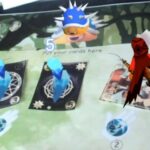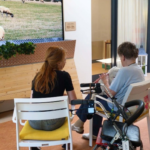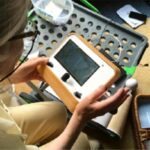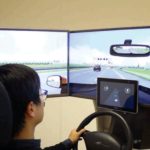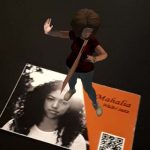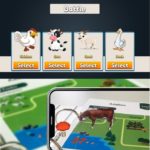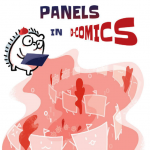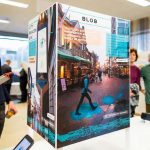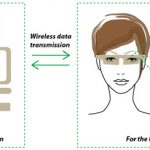Fostering fantasy play for young children through augmented reality has the potential to support 21st century learning activities by stimulating creativity, communication, and flexibility. We present a design exploration of MathMythos AR, an augmented reality card-based math addition game that enables children to engage in basic math tasks embedded in fantastical narratives. We provide insights into our design process, the effects of fantasy and everyday narratives, and discuss implications for AR card games that show potential to foster motivation for learning math. The presented insights are the foundation for the the next iteration of MathMythos AR, where we aim to create compelling and immersive AR narratives for learning.
Author: hj
Effects of the Level of Interactivity of a Social Robot and the Response of the Augmented Reality Display in Contextual Interactions of People with Dementia
The well-being of people with dementia (PWD) living in long-term care facilities is hindered due to disengagement and social isolation. Animal-like social robots are increasingly used in dementia care as they can provide companionship and engage PWD in meaningful activities. While most previous human–robot interaction (HRI) research studied engagement independent from the context, recent findings indicate that the context of HRI sessions has an impact on user engagement. This study aims to explore the effects of contextual interactions between PWD and a social robot embedded in the augmented responsive environment. Three experimental conditions were compared: reactive context-enhanced robot interaction; dynamic context-enhanced interaction with a static robot; a control condition with only the dynamic context presented. Effectiveness evaluations were performed with 16 participants using four observational rating scales on observed engagement, affective states, and apathy related behaviors. Findings suggested that the higher level of interactivity of a social robot and the interactive contextualized feedback helped capture and maintain users’ attention during engagement; however, it did not significantly improve their positive affective states. Additionally, the presence of either a static or a proactive robot reduced apathy-related behaviors by facilitating purposeful activities, thus, motivating behavioral engagement.
Social Glasses: Simulating Interactive Gaze for Visually Impaired People in Face-to-Face Communication
Eye contact is crucial in social interactions, linking with sincerity and friendliness. However, blind people cannot see and make eye contact when they communicate with sighted people. It influences the involvement of blind people in blind-sighted conversations. Based on this context, we implemented Social glasses with an eye-tracking system, aiming to improve the communication quality between blind and sighted people in face-to-face conversations. Social glasses attempts to simulate the appropriate gaze for blind people, especially establishing the “eye contact” in blind-sighted conversations. To evaluate the impact of the interactive gaze displayed on the Social glasses, we performed dyadic conversation tests under four experimental conditions (No Gaze, Constant Gaze, Random Gaze, and Interactive Gaze) for 40 participants. Quantitative results showed that the Interactive gaze has a positive impact on improving the communication quality between blind and sighted people, which were consistent with a qualitative analysis of the participants’ comments.
Supporting intergenerational memento storytelling for older adults through a tangible display: a case study
Mementoes act as emotional companions that anchor stories. Older adults typically have a rich knowledge of family mementoes. However, storytelling and preservation of mementoes are still problematic for them: their mementoes are still mostly in physical format, which is difficult to share and preserve. Additionally, digital applications and websites for sharing mementoes usually are inaccessible for them. As a result, they spend much time collecting mementoes, but spend less time on telling and recording the related stories. In response to this, we report our study driven by the research questions: Rq1: What are the characteristics of older adults’ intergenerational memento storytelling? And Rq2: In which ways could a tangible display facilitate intergenerational memento storytelling for older adults? We designed a tangible device named Slots-Memento. We first conducted a preliminary evaluation to refine the prototype. In the field study, eight pairs of participants (each pair consisting of an older adult and his/her child) were recruited to use the prototype for around 1 week. Semi-structured interviews were then conducted both with the older adults and their children. Subsequently, mementoes collected were categorized and analyzed. Stories collected were firstly transcribed, then were conducted with structural and interactional analysis. In the concluding discussion, we present abstract implications for the research questions: two tables summarizing characteristics of their intergenerational memento storytelling, and related strategies of designing a tangible display individually.
Enhancing Social Closeness between Drivers by Digital Augmentation
Chao Wang, Jacques Terken, Jun Hu, and Matthias Rauterberg
Driving is a social activity: Drivers need to coordinate and cooperate with each other to share the infrastructure. The relationship between drivers influences their driving behavior and experience. Lights, horn and speed are the most frequently used means to exchange information, limiting both the range and the bandwidth of the connectivity and leading to isolation, loneliness, and competition. We present “iSticker” and “MusicHound”, two concepts that aim to establish a connection by presenting similarity information between drivers. The two concepts were prototyped and evaluated with users in a driving simulator. The results showed that iSticker and MusicHound enhance drivers’ social closeness with each other and belongingness during the journey.
Explortists
FBP by Tess Ernest
The goal of this project is to create a service for artists that helps to enlarge their audience. This will be done by making it easy to explore new artists by using Explortists. Explortists are cards linked to an Augmented Reality application. The cards should make listeners more aware of the artist and stimulate sharing music. Outcomes of user-tests confirmed the willingness to explore via the cards. It also shows that using newer technology for the applications, makes the features clear, fun and valuable. Stakeholders such as artists, record labels and venue get profit out of the concept. They can implement personal branding and make a revenue out of using the cards.
To read more:
See Me Roar: an AR Game
See Me Roar: an AR Game to Improve Children’s
Perception of Relatedness and Learning Motivation in Elementary Math Education
M12 project by Xiaoyu Yu
Today’s primary school teachers may find it hard to motivate their students into traditional learning activities, especially with subjects which students may find difficult and are subsequently not willing to spend much time on, such as mathematics. Educational games with Augmented Reality (AR) technology could provide a great potential for learning and are increasingly available among primary school students. However, there is a lack of understanding on how to improve student’s learning motivation through the AR educational games. In the present study, the researcher first used the method of co-design with children to shape and develop the concept of an AR game for children to practice their math skills in the social learning environment. Then, the researcher conducted a user test with four 8-12-year-old students to explore which game elements (collaboration vs. competition) in the AR game could improve their perception of relatedness and motivation based on Self-determination Theory. The results show that the collaboration version could lead to a higher perception of relatedness and more learning motivation.
Segmentation of Panels in d-Comics
PhD Thesis by Xinwei Wang
“Comics are a storytelling medium. There are several practices which revolve around this medium: “the industry that produces comics, the community that embraces them, the content which they represent, and the avenues in which they appear [@Cohn2005]”. For over a hundred years, comics were presented on paper-based carriers such as magazines and books. With the development of new technologies, the comics industry has the opportunity to embrace a new carrier – the digital environment in electronic devices.”
To read more:
IoT in the City: Data Awareness at Stratumseind
Excellent B2 project work by Noa van den Brink, Teun van Acker and Renate Voss
The municipality of Eindhoven is always working on innovation and are working with new IoT technologies and sensors in public spaces, based on gathering and analyzing people’s data to improve the quality of life in the city.
At Stratumseind, there is such a sensor network which gathers data to solve issues in daily lives like safety. As local government, Eindhoven has to ensure that use of technology and data in the public space is visible, transparent, open, secure and respects the privacy of individuals and communities, which means that it is anonymous at all time. It is known that in Eindhoven a number of IoT / sensor networks in the public space work independently and are used by different parties and stakeholders. However, not everyone is aware of this sensor network and it has become clear that visualization and interaction with IoT in public spaces is a challenge. Especially, now privacy has become on of the main hot topics in the rapid digitizing world, think about The General Data Protection Regulation which is introduced in the EU in May 2018, (local) governments are looking for ways to implement new technologies in a transparent and democratic way. Therefore, as a leading municipality, Eindhoven wants to make it known and clear to everyone where the measuring equipment is located, what is measured and by whom, to ensure the public interest and stimulate innovation with the use of new technologies. …
Social glasses : designing gaze behaviors for visually impaired people
Gaze has important social meanings in face-to-face communication. A sighted person often uses various eye gestures to convey nonverbal information that a blind conversation partner cannot access and respond. In many examples, the eyes of blind people seem unattractive, and often with deformities, which make the eye appearances less appealing to sighted people. These factors influence the smooth communication between blind and sighted people.
Our research is to simulate the gaze for blind people, aiming at improving the quality of face-to-face communication between blind and sighted people. In this dissertation, the purpose of simulating the gaze includes two aspects: to assist blind people to perceive the gaze from the sighted and to simulate the appropriate gaze for blind people as a visual reaction.
